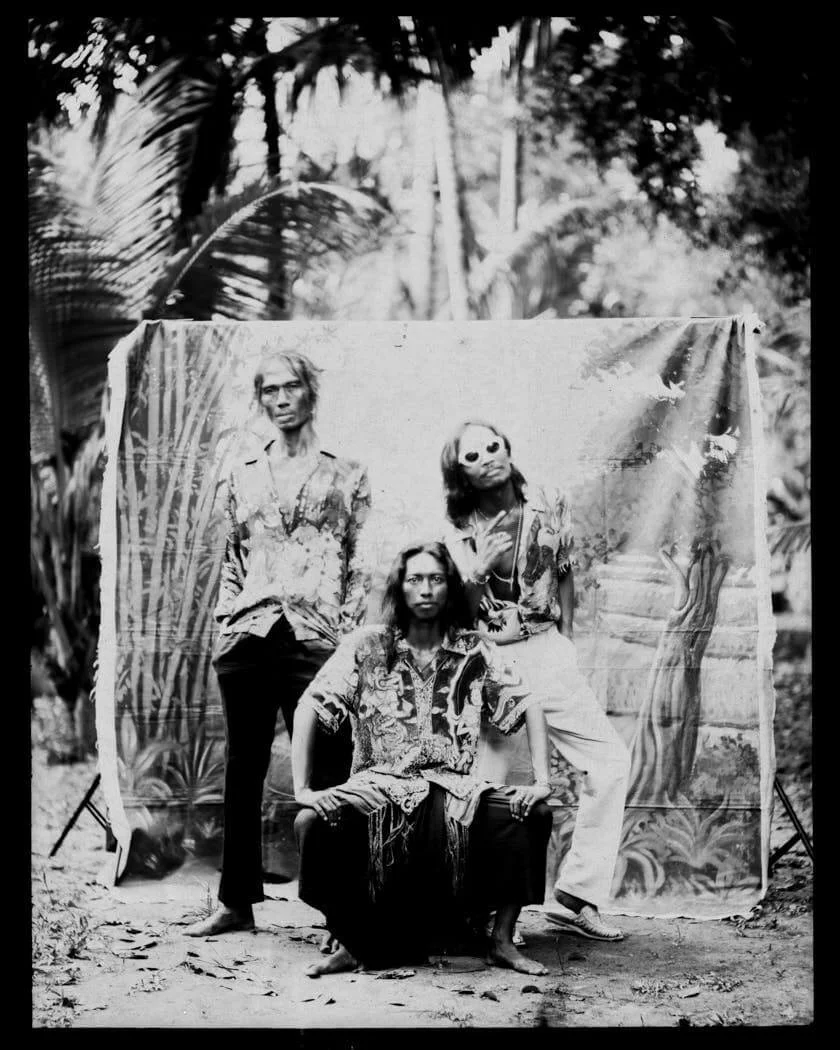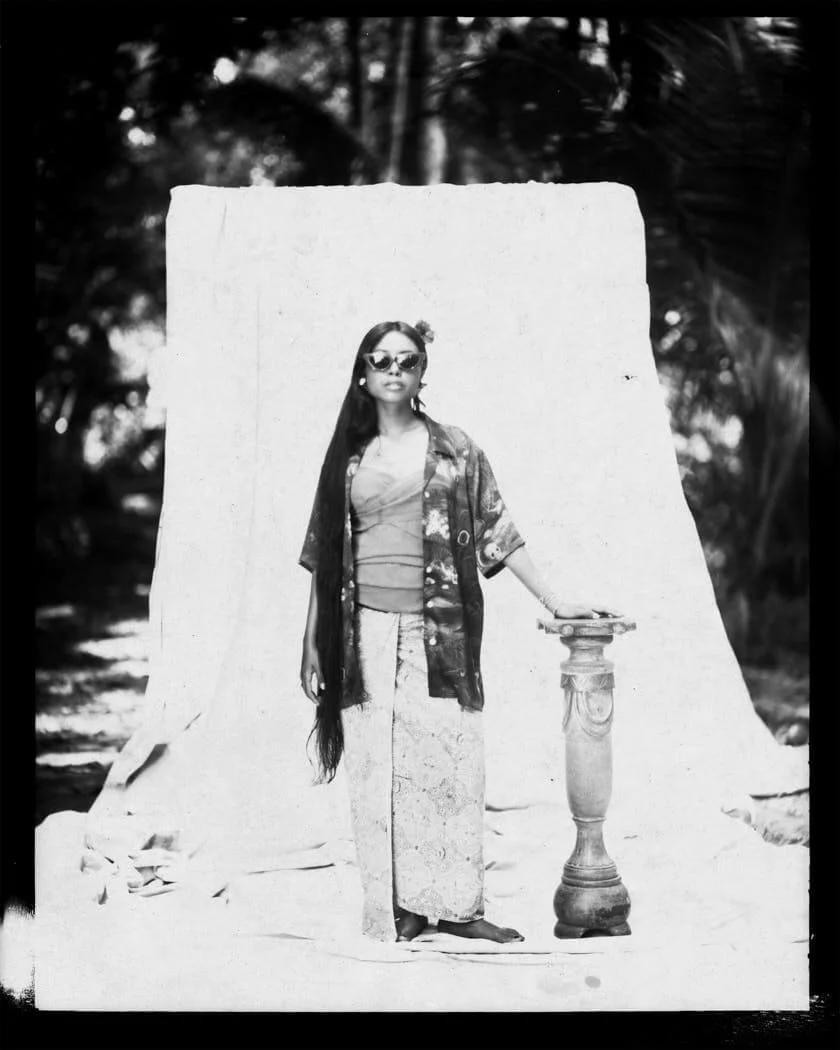ENDLESS JOY
*The Priest, the Chef, and the Camera in the Jungle
written ADRIAN COLTER
There’s a certain way light touches skin in Bali that makes everything look like a ceremony, even when it’s just someone eating rice alone at 11am with one leg curled under the other and a small dog under the table, staring as if it knows something you don't.
This kind of place speaks through silence and sweat and cotton that sticks to the middle of your back in a way that makes you aware of your own pulse. So when Endless Joy decides to tell a story here, one that floats somewhere within fashion and folklore and something they’ve agreed to call Taksu, it becomes clear they offer more than garments inspired by the island. They’re wrapping up a worldview in fabric and tossing it over your shoulders like a wet blessing.
Endless Joy, SS25
seen GUNG AMA
Endless Joy, SS25
seen GUNG AMA
You have to imagine it as a séance conducted by two expats with a really good sense of color and a surprisingly respectful understanding of animist spirituality. Enter Gung Ama, the photographer with a camera that breathes, and a way of standing still that draws people into speaking more truthfully, even in silence. He works with an Afghan box camera, a device built around chemistry and intention and waiting. No assistants, no light rigs, no LCD screens blinking into feedback loops. Just the kind of waiting that makes time expand and eyes look away, then back again, when they realise they’re being seen.
Together, they’ve chosen five Balinese creatives, though “creatives” floats slightly too sterile for what these people do. There’s a priest, quiet in title but expansive in presence; a chef whose food carries the weight of earth and apology; a dancer moving through space with the assurance of someone who has listened to trees; a visual artist with turmeric beneath the nails and memory in the knuckles; and a musician whose instruments continue breathing between each note. Each of them captured mid-being, a state Gung Ama enters with that box of his and that way he listens without nodding. Endless Joy continues to exist in that space shaped by the poetic and the mythological, guided by a density of print that gathers meaning with each layer and a looseness of certainty that allows form to remain open, a kind of slow unfolding that settles through gesture and holds within intention, and here, in the moss-laden air of Ubud, that unfolding reaches a saturation point, the clothing not placed upon the environment but absorbed by it, absorbed into it, held within its breath and dampness and murmur, the fabric gathering story as residue, carrying the cadence of something spoken inward, and once touched, once held, the vibration begins almost imperceptibly, somewhere beneath the surface of language, somewhere between texture and heat. The collaboration expands without circling memory, drawing on the presence of the box camera, the grain of black-and-white film, the full weight of an analogue process that seek to meet, and what comes through is not recollection or reference but contact, direct and immediate, already living, already rooted, already woven into the space between palm frond and ankle bracelet, between the accumulation of sweat and the sound of oil meeting iron in the first breath of morning.
Endless Joy, SS25
seen GUNG AMA
Endless Joy, SS25
seen GUNG AMA
Endless Joy, SS25
seen GUNG AMA
Taksu holds its ground beyond description, evading the frame of search engines and definitions, remaining instead in the charged pause before thought, in the interval that hums just before articulation, transmitting itself through sensation, a force that rises through the hands and exits through the act, made visible only in what it produces, as pulse, as field, as presence that lingers in the eyes, in the breath, in the stillness of those portrayed. The people here carry it completely, through the sheer fact of being, and the garments shaped around them hold that same frequency, neither reflecting nor responding but residing within it, holding it as they move, as they are worn, as they accompany the body through space with an attuned stillness that remains.
Temu Space, where all this unfolded, holds presence in everything it touches, with trees gathering stillness at the edge of movement, stones settled into quiet alignment, and air thick with sound and heat, as the space draws the work inward and lets it grow through rhythm, through repetition, through a making that expands without beginning or end. Intention settles early and shapes the atmosphere through quiet accumulation, as each gesture returns to the last with memory already held in the motion. Endless Joy moves within this field, responding to what surrounds it, and what takes form carries the same density, thread and pigment moving with weight and quiet insistence, folding into the air, holding its place.
Within a visual culture marked by repetition and gestures that circulate with speed, there is a shift here toward authorship that builds from the inside, shaped by the people who hold the language of the place through action, through practice, through the way rhythm moves through the body and the way sound settles into ground. What forms here follows that rhythm, held in depth, and the field continues to vibrate with what has been made as extension. The clothing arrives through this same process, carrying silk, carrying illustration, carrying the line of the portraits, with the surface moving in layers and the depth sitting just underneath, asking for wear, duration, presence, and for the continuation of something that has already begun. The work holds memory, holds gesture, holds temperature, and circulates as a field that stays near the body and moves with it.
Fashion here opens space, reshaping how the body moves and memory holds, as time folds into fabric drawn with intention. Something older moves through each piece—steady, unhurried, fully formed—and once worn, the garment speaks through presence, holding the trace, carrying atmosphere, returning the story into the world.






